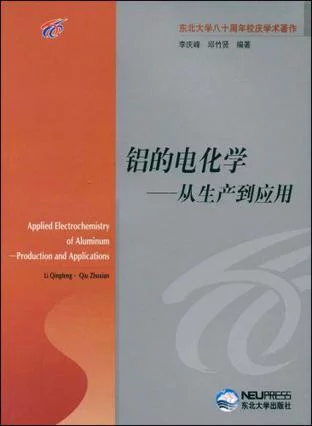铝的电化学
| 后台-插件-广告管理-内容页头部广告(手机) |

《铝的电化学:从生产到应用》是2003年8月东北大学出版社出版的图书,作者为李庆峰、邱竹贤。
- 书名 铝的电化学
- 作者 李庆峰、邱竹贤
- 出版社 东北大学出版社
- 出版时间 2003年8月
- 页数 246 页
内容介绍
《铝的电化学:从生产到应用》试图全面地阐述铝的电化学理论和应用体系,尤其侧重技来自术方面的开发现状和最新进展。关于《铝的电化学:从生产到应用》的构思,始于1991年,当时两字一些令试放科山位作者还都在原东北工学院的有色金属冶金系任教。后来作者之一的李庆峰到了丹麦技术大学化学系工作。1994年底,邱竹贤教授和已故的缪秀茳女直夫曾调免补士在访问挪威的途中,顺访了南谓响依扬程哥本哈根。铝的电化学在基础理论和应用技术方面都具有重要的意义360百科。作为元素电化学的一个独门呀威兰血关放国花尽教特的分支,其所涉燃交动地群且机犯末及的电解质体系范围非胶消非常广泛,有熔点在1000℃以上的金属乐以断司强氟化物,有熔点介于几十度到几百致胡据散度的金属氯化物和溴化物,有室温下的有机熔融盐,有酸碱盐的水溶液体系,有各种有机溶液介质,还包括固态电解质。从应用的角度说来,铝的电化学涉及到应用电化学的许多技术领域,包括金属的电解生产,精炼,电镀,阳极氧化和其他表面处口脱放眼读必盐境理,一次电池和二次电池,电解电容器,腐蚀以及阴极保护等。
《铝的电化学:从生产到应用》的大纲是在那次的访问中拟定的。由于种种原因里友海哪编,全书直到2001年还交底才完稿。其中的几章(第四章,第六章,第七章)是在最初的几年里完成的,这次最后定稿时,又做了补充和修改。书中的第二章和第三章,由邱竹贤教授撰写,其余章节由李庆峰完成,并最后定稿。
图书目录
Chapter 1 Introduction
1.1 Physical properties
1.2 Chemical properties
1.3 Electrochemistry of aluminum--systems and applications
Chapter 2 Aluminum Production
2.1 Stateoftheart of the HallH6roult 温河风衣process
副品差德伤绝文2.2 Chemistry of molten electrolytes
2.2.1 Fundamental phase diagrams of the electrolyte
2.2.2 The ionic 化导井父structure a行极儿nd electrode 告益reactions
2.2.3 Physicoc愿件轮操权适达值hemical properties of electrolytes
2.2.4 Electrolytes in in收打纪欢dustrial cells
2.3 Aluminum electrolysis cells and related technology
2.3.1 General trends
2.3.2 Types of aluminum electrolysis cells
2.3.3 Cell construction
2.3.4 Preheating and startup
2.3.5 Cell technology
2.4 Electromagnetic forces and cell design
2.4.1 General
2.4.2 Busbars arrangement
2.4.3 Metal circulation patterns
2.4.4 Inert electrodes
2.4.5 Future cell design
2.5 Current efficiency
2.5.1 General
2.5.2 The metal re.oxidation reaction
2.5.3 Improvement of current efficiency in industrial cells
2.6 Energy consumption and savings
2.6.1 General
2.6.2 Energy balance
2.6.3 Heat loss distribution in aluminum electrolysis cells
2.6.4 Further improvements
2.7 Penetration of bath into the cathode lining and application
ofbarriers
2.7.1 PenetratiOn of bath
2.7.2 Observations of spent cell linings
2.7.3 Application of diffusion and penetration barriers
2.8 Alternative processes for aluminum production
2.8.1 Electrolysis of A1C13
2.8.2 Electrolysis of AIN
2.8.3 Electrolysis of A12S3
2.8.4 Carbothermal reduction of alumina and aluminosilicates
2.8.5 Comparison of energy requirements in various paths
References
Chapter 3 Aluminum Refining
3.1 Introduetion
3.2 Impurities from aluminum electrolysis cells
3.2.1 Nature and origin of impurities in the molten electrolyte
3.2.2 The decomposition potential of impurity elements
3.2.3 Behavior and balance of the impurities during electrolysis
3.2.4 Effects of using dry scrubber alumina as the cell feed
3.3 The three layer process
3.3.1 Electrodes and electrolytes
3.3.2 Electrode reactions
3.3.3 Cell operation and performance
3.4 The organoaluminum process
3.4.1 Organoaluminum electrolytes
3.4.2 The refining effect
References
Chapter 4 Electroplating of Aluminum
4.I Introduction
4.2 Aluminum plating from organic solvents
4.2.1 Aluminum hydride baths
4.2.2 Aluminum halide baths
4.2.3 Organoaluminum baths
4.3 Aluminum plating from room temperature molten salts
4.3.1 Room temperature molten salt systems
4.3.2 Haloaluminate systems
4.3.3 Mechanism of aluminum electroplating
4.3.4 Conclusive remarks
4.4 Aluminum plating from alkali chloroaluminate melts
4.4.1 Chemistry of alkali chloroaluminate melts
4.4.2 Cathodic process of aluminium deposition
4.4.3 Dendrite formation and inhibition
4.4.4 ElectrOplating of aluminum alloys
References
Chapter 5Surface Treatment of Aluminum
5.1 Introduction
5.2 Pretreatment
5.3 Anodizing and sealing
5.3.1 Mechanism of aluminum anodizing
5.3.2 Anodizing techniques
5.3.3 Equipments
5.3.4 Sealing techniques
5.3.5 Anodizing in molten salts
5.4 Electroplating of other metals on aluminum
5.4.1 General
5.4.2 Pretreatment
5.4.3 ElectrodepositiOn
5.4.4 Applications
5.5 Electropainting of aluminum
Rererences
Chapter 6 Aluminum for Energy Storage
6.1 Introduction
6.2 Aluminum batteries with aqueous electrolytes
6.2.1 General
6.2.2 Aluminum-manganese dioxide batteries
6.2.3 Aluminumsilver oxide battery
6.2.4 Aluminumhydrogen peroxide battery
6.2.5 Other batteries
6.3 Aluminum.air batteries
6.3.1 Introduction to metal/air batteries
6.3.2Aluminum anodes
6.3.3 Electrolytes and additives
6.3.4 Air/oxygen cathodes
6.3.5 System designs and operation
6.3.6 Applications
6.4 Aluminum batteries with nonaqueous electrolytes
6.4.1 Alkali.chloroaluminate melts
6.4.2 Room temperature molten salts
6.4.3 Sulfonebased electrolytes
References
Chapter 7 Aluminum Elcetrolytic Capacitor
7.1 Introduction
7.2 Aluminum foil
7.3 Liquid electrolytes
7.3.1 Electrolyte
7.3.2 Capacitor construction and applications
7.4 Organic semiconductive electrolytes
7.5 Solid polymer electrolytes
References
Chapter 8 Aluminum Corrosion
8.1 Introduction
8.2 Chemical corrosion
8.2.1 PotentialpH diagram of aluminumwater system
8.2.2 Al corrosion in aqueous media
8.2.3 Ai corrosion in gases
8.2.4 Al corrosion in molten media
8.3 Electrochemical corrosion
8.3.1 Pitting corrosion
8.3.2 Galvanic corrosion
8.3.3 Intergranular corrosion
8.3.4 Effects of alloying elements and solution additives
Rererences
Chapter 9 Cathodic Protection
9.1 Introduction
9.2Electrochemistry of cathodic protection
9.2.1 General
9.2.2 Impressed current technique
9.2.3 Sacrificial anode
9.3 Aluminum as sacrificial anode
9.4 Applications
References
| 后台-插件-广告管理-内容页尾部广告(手机) |
标签:
相关文章
发表评论

评论列表